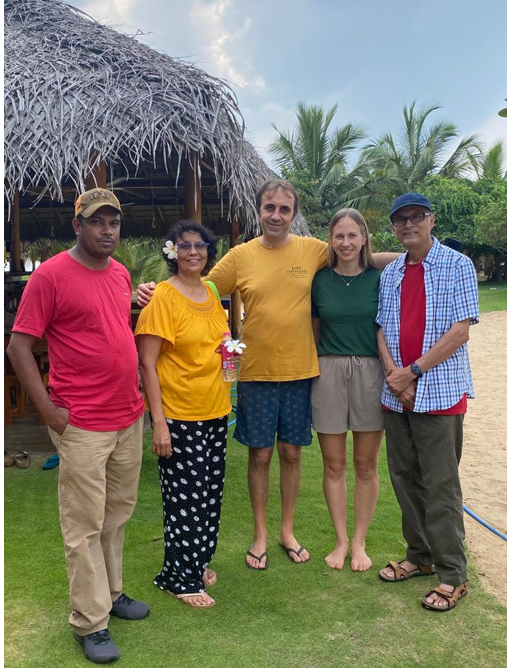In a “bankrupt” country – By George Braine
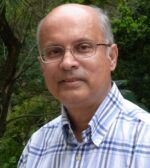 The hardest part were the power cuts, one in the afternoon (when the temperature felt like 38 centigrade, with added humidity), and again around 7 pm, for a total of three hours. I had a battery operated radio, and two rechargeable lights for the evening cut. Thankfully, three weeks into my stay, the cuts ended.
The hardest part were the power cuts, one in the afternoon (when the temperature felt like 38 centigrade, with added humidity), and again around 7 pm, for a total of three hours. I had a battery operated radio, and two rechargeable lights for the evening cut. Thankfully, three weeks into my stay, the cuts ended.
I last visited Sri Lanka in late 2021, when travel restrictions were tough and changing frequently. Sri Lankan Airlines suddenly canceled the outbound flight, throwing my internal flights and hotel bookings in Japan to disarray. Then, upon return to Japan, I had to quarantine in a hotel for 14 days, under strict supervision. In comparison, the journey this year was a breeze, and not having to wear a face mask in Sri Lanka came as a relief.
The endless petrol and cooking-gas queues seen worldwide on TV were gone. And the roads, as always, were crowded with vehicles. Supermarkets had fewer customers, although the shelves were full. In contrast, even well-known appliance stores had nearly bare shelves. Every item has more than doubled in price. Only a few hard copies of newspapers – much thinner than in the past – were available. Almost everyone I spoke to, ordinary villagers included, expected the economy to worsen.
The interest rates for loans is around 30%, and small businesses are on the verge of extinction. The cost of living has risen sharply, income taxes and electricity charges have increased, so even the middle class is struggling. Yet, a distant relative, a mason without steady employment but with support from relatives in Italy, had spent Rs. 500,000 on a photoshoot for his daughter’s wedding. Construction of new houses is at a standstill, so masons and carpenters don’t have steady work. Some homeowners are having their houses painted, because, with unemployment rife, a laborer can be hired for as little as Rs. 2000 per day. When I had my house painted, I doubled that rate.
Boralessa, the village 40km from Colombo where I live, has many residents in Italy, so money is still flowing in. Most people manage to make a living. But more people came to me asking for help than at any other time (mainly for medical needs), one with an outlandish business idea that would surely have bankrupted her, disappearing my “loan” into thin air.
Many of the so called “Italians” built palatial houses in my area, mainly to show off their wealth. They would come on annual visits and spend lavishly. With covid and the economic collapse, that stopped. Most startlingly, a large number of these houses appear to be abandoned, the owners having returned to Italy for good. (see photo) Within a 200-meter radius of my modest home, I could count about ten such houses, with moldy walls, cracked tiles, and gardens covered in weeds. From my verandah, I see a large, two storied house, built five years ago, which has never been occupied.
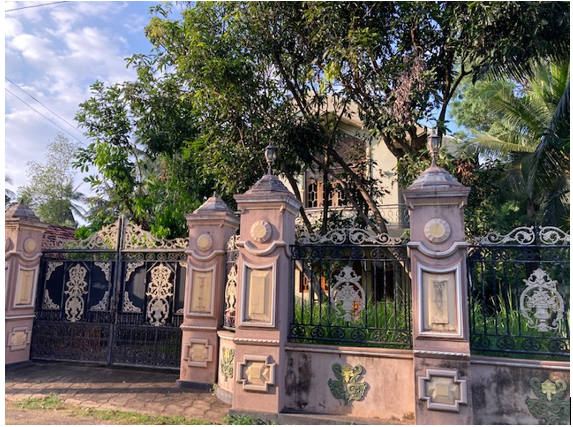
Every able bodied male is trying to go abroad or already has. Even females. Two women who are my neighbors, a mother and a daughter, left for Romania as seamstresses. Each paid about fifteen lakhs (1,500,00) rupees as agency fees. Romania is not a prosperous country, so their ultimate aim is to enter Italy, illegally of course; people in my area have been doing it for forty years.
I drove to Colombo a few times. My sister and a couple of old friends live in Colombo, and I enjoy being in their homes. But getting there – battling kamikaze pedestrians, motorcyclists, and tuk-tuks; passing through chaotic slum areas; the noise and the smoke-filled air, the beggars – still make a trip to the city a disheartening, stressful experience. The traffic was bumper to bumper, “bankrupt” economy or not.
Beyond Colombo
I jointly own a small property named Bellwood Farm in Galaha with my BIL. It’s a remnant of the vast Bellwood plantation, which has been divided and subdivided over the years.
The price of raw tea leaves has shot up to Rs. 200 per kilo, which attracts thieves. Recently, freshly plucked tea leaves as well as 300 saplings have been stolen from the farm. Not much can be done, because it’s happening everywhere.
To reach Galaha, I usually take the narrow road from Kandy that goes through Hantana Estate. This used to be a picturesque route, winding through terraced tea, pine-scented air, forest, and breathtaking valleys. This time, huge, lumbering buses were going up the road from Kandy, spewing smoke, covering the roadside in dust. I saw about ten buses parked on a hillside cleared of tea bushes, and a few shacks selling tea, soft drinks and betel were already in business. Apparently, a Buddhist shrine (they called it a “saeya”) has been recently constructed nearby, drawing pilgrims from all over the country.
The traffic, and the crowds, will be the death knell of Hantana, a haven from the crowded and polluted Kandy town. How long will the estate, which has been plundered for years (I know, because I owned a house nearby), survive?
While visiting Bellwood, I stayed at a small hotel nearby. That night, the area lit up with a spectacular forest fire.
My second excursion was to a small village, Maediliya, near Hemmathagama in the Mawanella area. A distant relative, who was born in the village but rose to manage a multinational factory at the Free Trade Zone, had set-up a plant at his birthplace to manufacture sensor parts (load cells) for weighing scales, to be exported to the USA. The cells are used worldwide in diverse sectors such as retail stores, agriculture, the military, the medical field, oil and gas industries, even in the weighing of aircraft and spaceships.
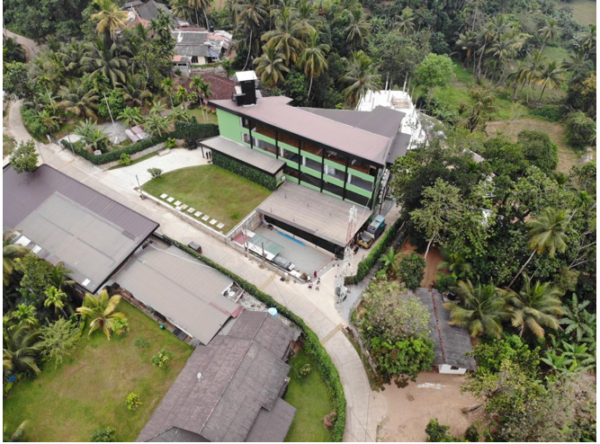
To come upon the five storied ultramodern factory, amidst the paddy fields and coconut groves of Maediliya, was startling. To see 200 young men and women from the surrounding villages handling high tech equipment, in well paid jobs, being able to travel from home, was pleasing. This is the second factory of the company, the original location being at Dankotuwa in the NWP.
Whiskey Point, etc
In the Eastern Province, I had never visited Pottuvil or Kumana, on the northern border of the Yala Sanctuary, or the Senanayake Samudra, near Ampara. On this visit to Sri Lanka, I wanted to ensure that I did.
First, I needed a place to stay. Looking for hotels, I came across Whiskey Point Resort, which, astonishingly, had earned more than 50 reviews on TripAdvisor, all five star! I booked four nights.
To get there, I traveled with my sister, nephew, and part-time driver Gamini. Having borrowed two QR codes for the fuel needed. Making an early start, we chose the Southern Highway from Colombo to Hambantota, and from there, went north to Wellawaya on the A2 road. From Wellawaya, we turned east on the A4, passing through Buttala, Monaragala, Siyambalanduwa, Lahugala, and Pottuvil. The 400+km trip, on good roads, with stops for breakfast and lunch, took only 9 hours. We had traveled through five provinces – the NWP, Western, Southern, Uva and onto Eastern.
We had breakfast at Welipenna. The rest stop, after a decline during covid, is back in business. But, ordering a cup of milk tea without sugar was a problem. Only condensed milk was available, and the servers didn’t know that it was high in sugar. I had to face this issue again and again in Sri Lanka. Don’t they read labels?
Another problem was getting a simple rice and curry meal. Every place we visited, from a wayside “hotel” to an expensive restaurant, only offered what they call “rice”, the term for fried rice. Who could tell what was fried, and how many times the oil had been recycled?
The highway wasn’t busy, and, from Matara to Hambantota, a distance of 90 km, it was virtually deserted; I counted barely thirty vehicles traveling either way. What a waste of money. The smarter move would have been to build a highway to Kandy, but politics doesn’t work that way.
Getting off the highway at Mattala, we looked for a place to snack and use the toilets. No luck. All we saw were shabby structures offering coconut “roti” and plain tea. Some were on the verge of collapse, perhaps after being attacked by roving wild elephants. The lack of clean toilets bugged us throughout this trip, forcing us to wander into the bushes on the roadside.
We passed through much greenery, perhaps after the rains, including patches of paddy, coconut, sugarcane, and vegetables. We did not meet a substantial forest till Lahugala, but army camps and police checkpoints (where we were not stopped) were numerous. The occasional electrified elephant fence was visible roadside. Settlements or not, the elephants were around. Only 50 years ago, all this may have been thick forest.
Into the Eastern Province, the landscape changed. Instead of hills, we saw endless paddy fields, as far as the horizon. This was harvest time – the paddy was sea of gold – and we could see combine harvesters at work, and the bagged rice being loaded onto tractor trailers and trucks on the roadside. The fields, perhaps because of the shortage of fertilizer, didn’t look fertile.
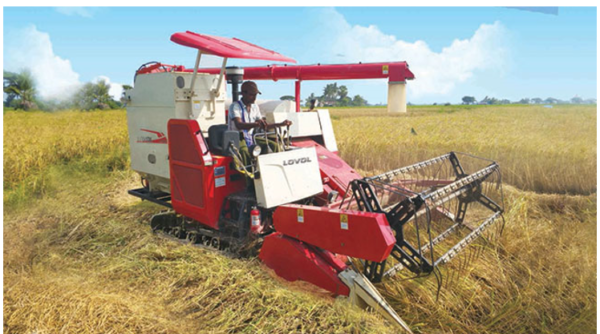
Interestingly, the Sinhala nickname for the harvester is “boothaya” (fearsome ghost). We were told that the cost of hiring one was Rs. 20,000 per day. In Sri Lanka, tractors have been used to plough paddy fields for decades, but the combine harvesters were only introduced about fifteen years ago. Till the, one can only imagine what a time consuming, back-breaking task large scale paddy harvesting would have been.
While the bags of paddy were being loaded, groups of women were collecting, by hand, rice that had spilled on the road. Without a village in sight, they must have walked miles under the blistering sun for a couple of kilos of paddy. This scene was repeated wherever the harvested rice was being loaded for transport. So much poverty in the midst of plenty.
Whiskey Point Resort was a relief after the long drive. Set within a lush coconut grove, with open access to the nearby beach, the place was managed by Nicola, an Italian, along with Anna, who was Russian, and Johanna, a German. Just four wooden cabanas with thatched roofs, and a large dining area in the center. We rushed to the beach, known as a surfers’ paradise, but none could be seen that day. The surfing season was yet to begin.
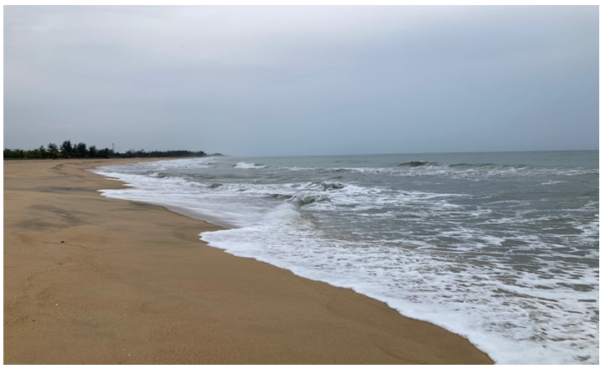
Nicola (Nico), usually bare chested, was the talker. Anna and Johanna, with eight staff members, did the work. I soon saw where the 50+ five-star reviews came from: surfers, who loved the laid-back ambience, the access to the beach, and the easy going threesome. Nicola said that Sri Lankans did not stay at the resort because it lacked air conditioning or TV. We didn’t care. The ceiling fan and the ocean breeze was enough.
Nico talked and talked, occasionally checking on the computer, while Anna rushed around, setting tables, taking orders, fixing drinks, serving meals, going in and out of the kitchen. The menu prices were in dollars, but the lavish complimentary English breakfast filled us up. The conversation and bonhomie, and the ambience, made us linger. The driver Gamini, who sat with us, was so taken up that he decided to learn English!
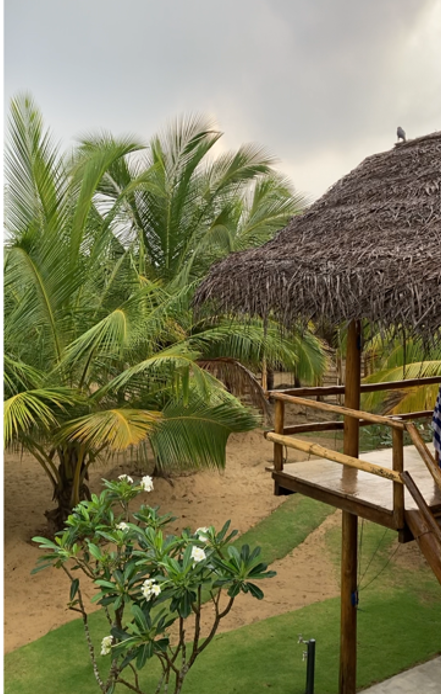
This is elephant country, and, with its young coconut plantation, the resort should be a prime target. Instead, the neighboring hotel had been attacked, forcing it to shut-down in the coming season.
For dinner, we drove to nearby Arugam Bay, which has a “tourism zone” with hotels and restaurants. The tourists hadn’t arrived yet, and the area was dark and gloomy. Most places were empty of customers, or advertised their prices in dollars, and the people who hung around didn’t inspire confidence. Seafood should have been cheaper. Once again, getting a rice and curry meal was a challenge.
One evening, we tried Pottuvil, walking along the lively street till we found a clean, well-lit, eating place. The town appeared to be a throwback to the 1980s, the only new buildings being the banks. All three communities – Muslims, Tamils, and the Sinhalese – appeared to be getting along.
I wanted to visit the Kumana area, not for the famous bird sanctuary but for Kudumbigala, the 2000-year old forest hermitage. Warned that the roads were in bad shape, we hired a safari jeep at Rs. 15,000. Beyond Panama, the road became nonexistent, more potholes than tarmac; the jolting was hard on my old bones. As we arrived at the Kudumbigala hermitage, a van full of people was leaving; they had brought alms for the meditating monks.
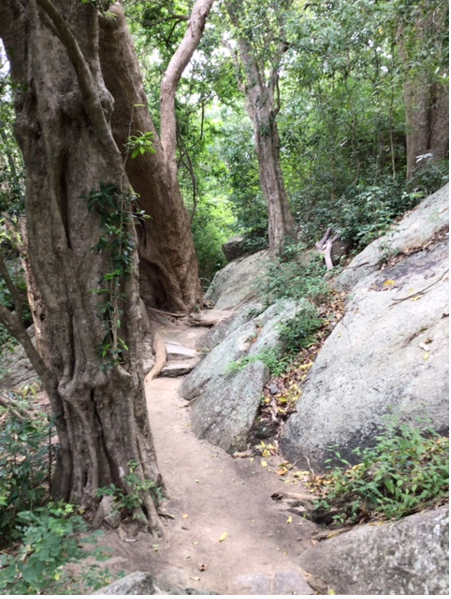
As we walked through into the forest, under overhanging rocks and gnarled, old trees, we saw that some paths were closed, with a sign that monks were meditating beyond. We only saw a couple of other visitors, scrambling down the rocky paths. Seeing that we were getting soaked in a sudden downpour, a monk invited us to his cell, under a huge overhanging rock. He was not a meditating monk, but the one who coordinated the alms for the monks. We chatted. His cell had electricity from solar power and pipe borne water. He said that elephants, leopards, and the bears that roamed caused no trouble, but the wild boars would charge without provocation. Alone in that thick jungle, night after night, would be unimaginable for me.
Senanayake Samudra, known as the largest reservoir in the country, was also on my “to do” list. So we drove back to Siyambalanduwa along the A4, and took the A25 road towards the Galoya National Park. We passed through sparsely populated areas, the presence of wild elephants marked by the electric fences on the roadside.
When the road entered the national park, we began to drive through a lush, green forest. We did not encounter any animals, but the signs, such as fresh elephant dung, were there. Because of the rains, elephants would not have to travel far in search of water.
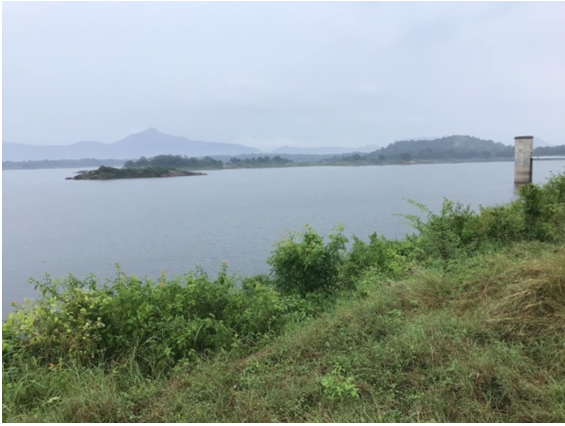
Senanayake Samudra (ocean) was built in the early 1950s under independent Ceylon’s first prime minister, DS Senanayake. The earthen dam constructed between two hills, one being the iconic Inginiyagala rock seen in the photo. The vast reservoir provides irrigation for thousands of acres of paddy fields and other crops. Below the dam are the fish hatcheries and a small hydropower station.
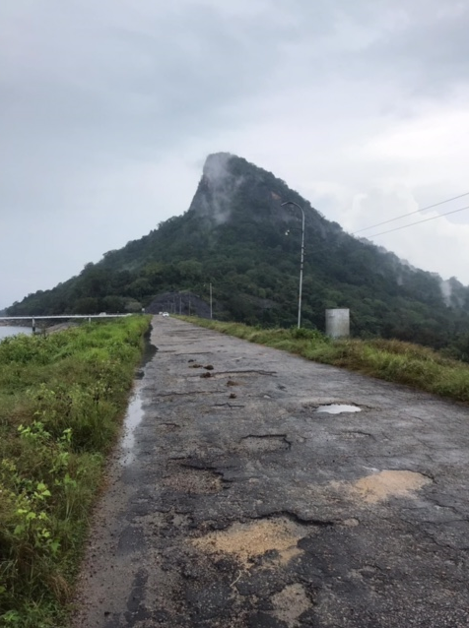
We later visited the area where the fish are brought ashore and saw about thirty boats, with outboard motors. Trucks leaden with fish were leaving as we drove up. I was told that, on certain days, up to 15,000kg of fish are caught in the samudra, mainly Tilapia (of African origin), Catla (Indian carp), and Chinese carp. I saw a giant Catla loaded onto the back of a tuk-tuk. Two older fisherman I spoke with, both retired government employees, were content with their lives.
Looking for a place to have lunch, we saw the sprawling Inginiyagala rest house, which had closed down. So we drove to Ampara town, and encountered the same problem there: the rest house was closed, and no place offered decent rice and curry. The town, having been carved out of the jungle, is well laid out.
We drove back to Whiskey Bay, east along the A31 and south on A4. These were mainly Muslim areas, the mosques often being the largest buildings. Paddy cultivation appeared to be the main means of livelihood.
When it was time to go, the next morning, Nico said that he would miss our company and offered another night’s stay, at no cost. But our plans were set and we had to leave. I left a generous tip for the staff.
Nico may not have a sound business plan, but does have a big heart. The resort does not need eight staff members, but he keeps them because, with tourism being down, jobs elsewhere are hard to come by.
